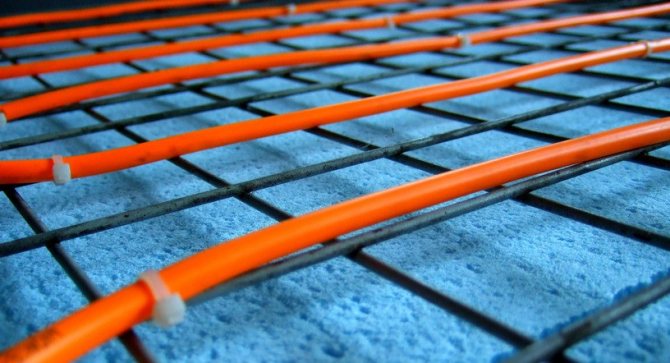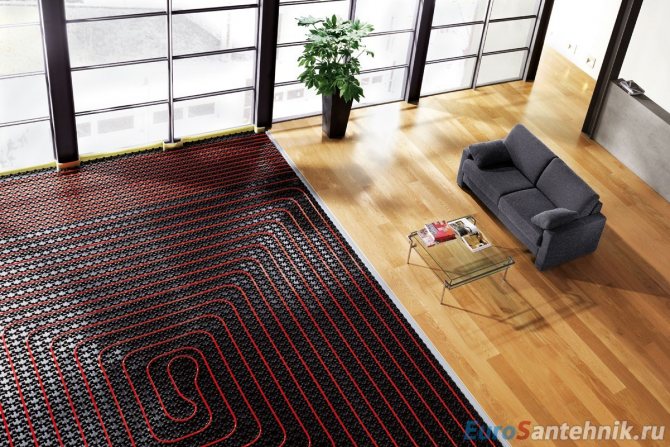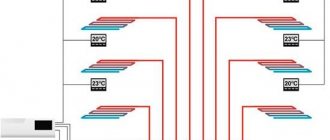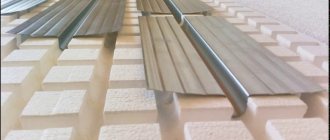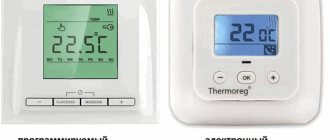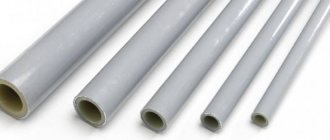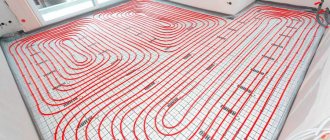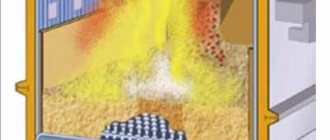When installing a warm floor, it is necessary not only to correctly perform the installation in compliance with the technology and all standards, you must also familiarize yourself with the gradation of the temperature regime. What is the temperature of the warm floor is considered borderline high, low or optimal? First of all, this knowledge is required to protect the flooring from damage (meaning ceramic tiles, parquet or linoleum). Often, users set their own parameters for the heating system, which negatively affects its operation.
Underfloor heating temperature
How does a warm floor work?
It is important to have an idea of the device and the features of the underfloor heating in order to understand how the temperature indicators can be adjusted and to what point, in principle, heating is possible. Regardless of the manufacturer or the type of system, the floor consists of several layers. There are only three of them. Only this design allows you to ensure the optimal floor temperature in the room. Now we will consider the features of each of these layers separately.
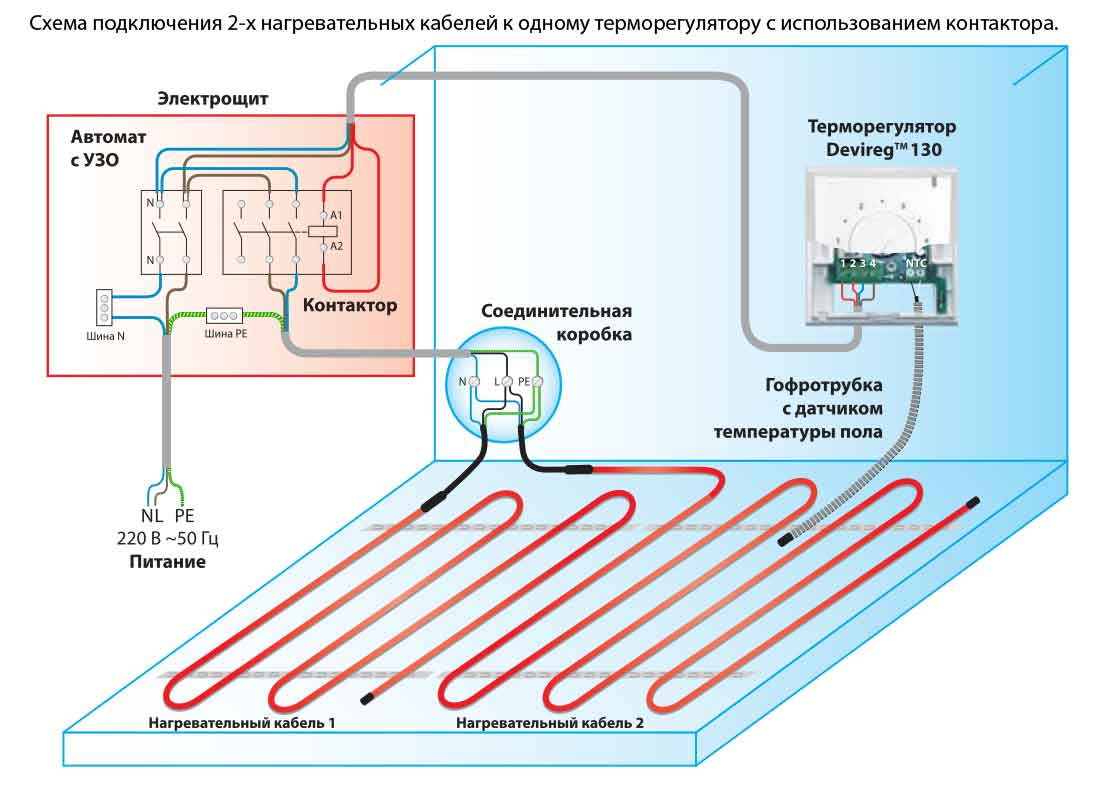
Electric floor heating connection diagram
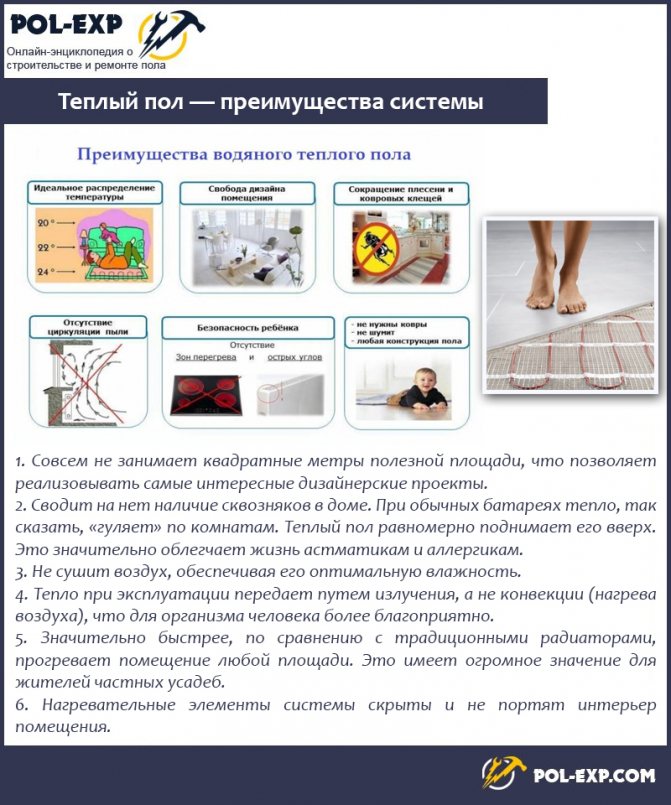

Warm floor - system advantages
First layer
It is a cement screed, on top of which a special substrate is laid, which has waterproof and heat-insulating properties. The main task of the underlay is to retain heat in the house and protect the lower floors from possible leaks. The screed also protects the pipeline from mechanical stress, which is very important during the installation phase.
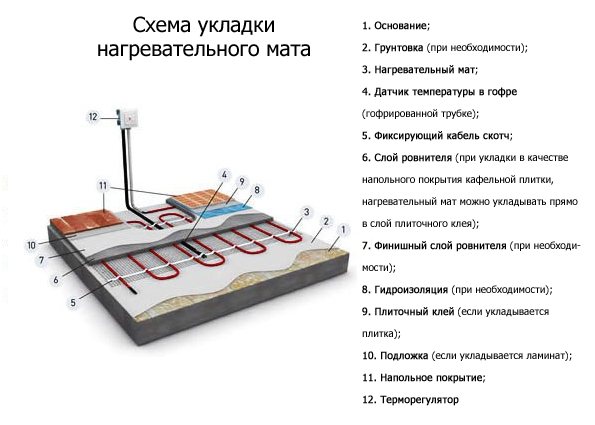

What does a warm floor device look like under a tile?
Second layer
The next layer of the underfloor heating system is a pipeline through which hot water or heat carrier circulates. For the manufacture of the pipeline, metal and expanded clay are most often used. When installing other heating systems, special heating elements are installed instead of the pipeline, although the water heating system is considered the most common (it is economical and safe).
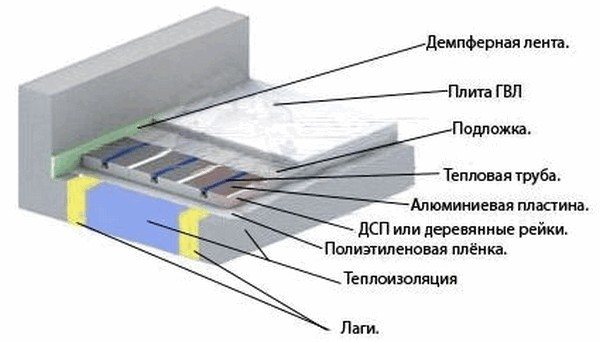

Water heat-insulated floor on logs
Third layer
The final layer of the system is a strong concrete screed that covers the pipeline. On top of the screed is a floor covering such as parquet or linoleum. There are several main requirements for a topcoat. First of all, it should not only be moisture resistant, it should also shouldn't be afraid of high temperatures.


Concrete layer - directly the floor screed
Prices for warm floors DEVI
Warm floors DEVI
Temperature standards for underfloor heating
SNiPom determined the strictest regulations on the optimal temperature for a warm floor. It states that the maximum and minimum temperature conditions should vary between 26 - 35 degrees Celsius.
It is recommended to maintain the minimum value when people are constantly in the room. If the attendance is rare, then the temperature should be closer to the mark of 31 degrees. This indicator is usually installed in the bathroom, sanitary facilities, swimming pools, where our feet most need comfort. The main limitation is that the temperature along the heating axes should not exceed the permissible limit, since the increased mode will cause overheating of the heating system and floor coverings.
For example, a parquet surface should warm up to 27 degrees. This limitation is due to the characteristics of the material and its temperature properties - excessive overheating will entail deformation.
So, what should be the temperature of the underfloor heating? The optimal solution is a mode of 22 - 24 degrees. This is enough to keep your feet warm, and the air flow in the room warms up evenly. The difference from the classic battery will be that the maximum air temperature is maintained throughout the entire area. In the practical application of underfloor heating systems, bringing the coolant to a maximum temperature of 30 degrees is a rare phenomenon.


The optimum temperature of the warm floor is 22-24 degrees
Usually, all parameters are determined at the design stage of the heated surface. Before installing a water or electric heating system, it is necessary to take into account all the tasks and indicators of heat loss in the room.
Optimum temperature readings
There is no definite answer to the question of what temperature of the warm floor is considered normal. After all, if we consider the situation from the side of building rules and regulations, then the temperature indicators will be the same, and if from the side of a person who lives in an apartment with a warm floor, then the comfortable temperature for him may be completely different. Therefore, first you need to understand the building codes and regulations (SNiP) - what are they talking about?
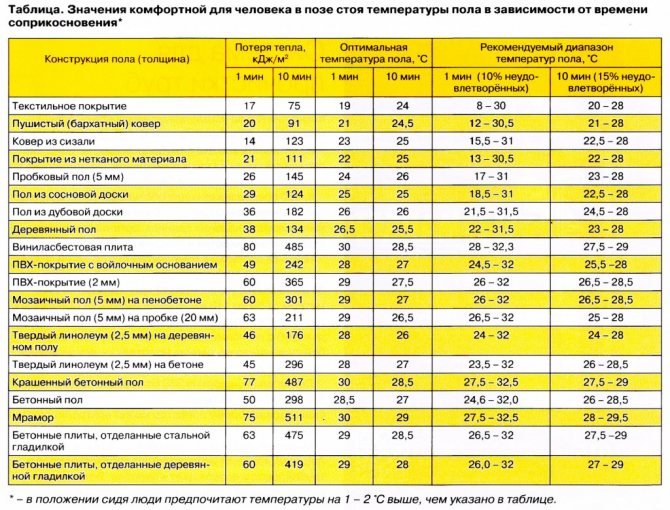

Comfortable temperature of warm floors for different coatings
Note! For premises where people are constantly staying, the optimum temperature is 26 ° C. These are areas such as the kitchen, living room and bedroom. The temperature of the underfloor heating for rooms in which people stay for a short time is 31 ° C. These are corridors, toilets and bathrooms.
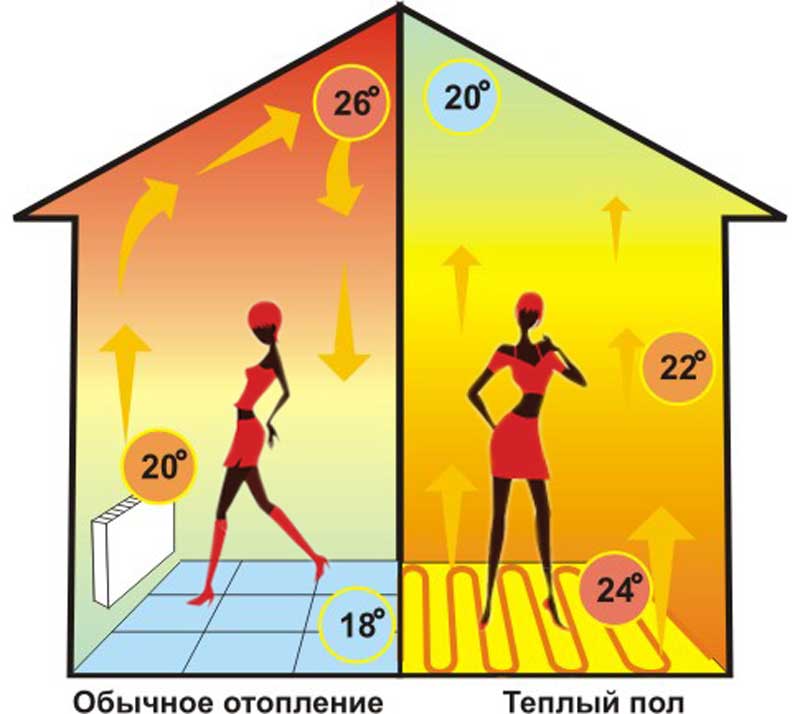

Heat distribution of the warm floor
Comfort temperature
In each case, the comfortable temperature is selected individually, so the indicators may differ from those established by building codes. Some people like a cool environment in the house, while others, on the contrary, prefer a warmer climate. Many people suffer from poor blood circulation in the lower extremities, which is why their feet often get cold. In this regard, the comfortable temperature for each individual person may be different..
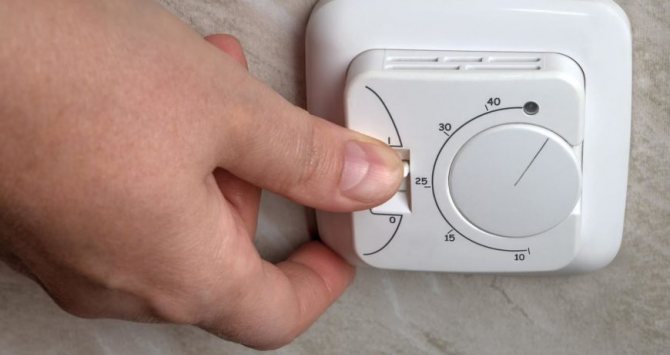

Optimum floor temperature
Prices for underfloor heating REHAU
Warm floors REHAU
Maximum temperature
Despite the individual preferences of each person, there are maximum values for the temperature of the warm floor, which are strictly not recommended to be exceeded. There are several reasons for this. Firstly, doctors do not recommend exceeding the temperature, since prolonged contact of the legs with the hot surface of the floor can provoke venous expansion of the veins. With constant exposure to heat, the veins will also continually expand.
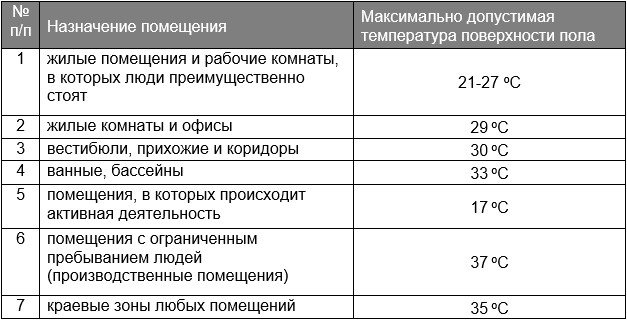

Limit (maximum) temperature of the heated floor surface
Secondly, if the floor overheats, the floor covering can suffer, especially if it is made of wood. Such coatings include parquet and laminate. These materials, under the influence of high temperatures, gradually dry out, which leads to the formation of cracks, and the material itself is quickly subject to wear.
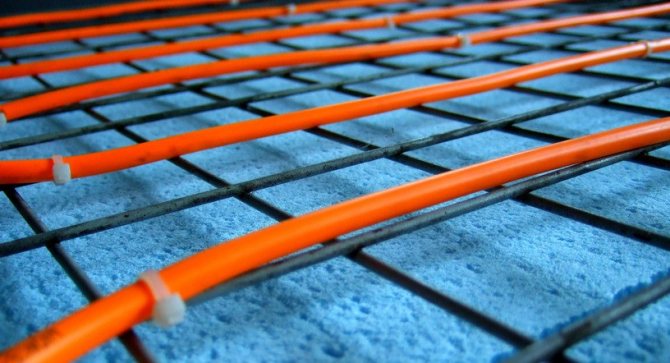

What is the optimal temperature for underfloor heating
Expert opinion
Afanasyev E.V.
Chief editor of the pol-exp.com project Engineer.
With prolonged overheating, linoleum can release formaldehydes - harmful substances that negatively affect the human body. Therefore, overheating of the floor should not be allowed when using linoleum as a floor covering.
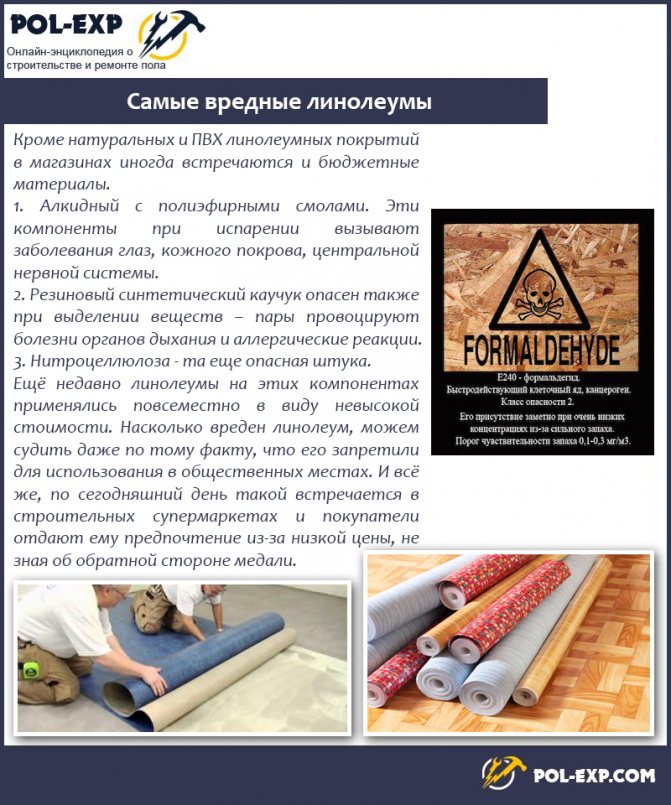

The most harmful linoleums
Warm floor: principles of creation, temperature, pros and cons
Warm floors are usually praised in such a way that many people forget about the two sides of the same coin. The heated floor has disadvantages that may not suit everyone. Or, certain principles of operation of this heating system cause concern among medical specialists.
Further, in more detail about the general principles of heating a house using underfloor heating, about the acceptable temperature to ensure comfort, the advantages and disadvantages that can affect the choice.
How does underfloor heating work, basic principles
The floor covering can be heated either by a hot pipeline, or by a heated electric cable, or by infrared electromagnetic radiation.
- Water floors form a heavy screed and a pipeline embedded in it. A coolant moves through the pipe, and the screed dissipates and distributes heat over the surface of the coating.
- An electric underfloor heating is heated with a cable, which is embedded in a thin screed, or in an adhesive under ceramic tiles.
- Infrared heating is created using a film electric infrared emitter placed under a dense floor covering. The principle is this: infrared radiation heats the hard flooring and objects in the room, from which the air is also heated.
Environmental friendliness, safety is important
The floor covering must not collapse, dry out and not emit harmful substances when heated.
It is recommended to pay attention to the choice of flooring for warm floors, to use, if possible, only natural non-synthetic materials.
The peculiarity inherent in electric heaters in the floor is the generated electromagnetic field. Experts warn against harmful effects, especially on children.
It is recommended to use only a water heating system. In addition, heating with electricity is expensive.
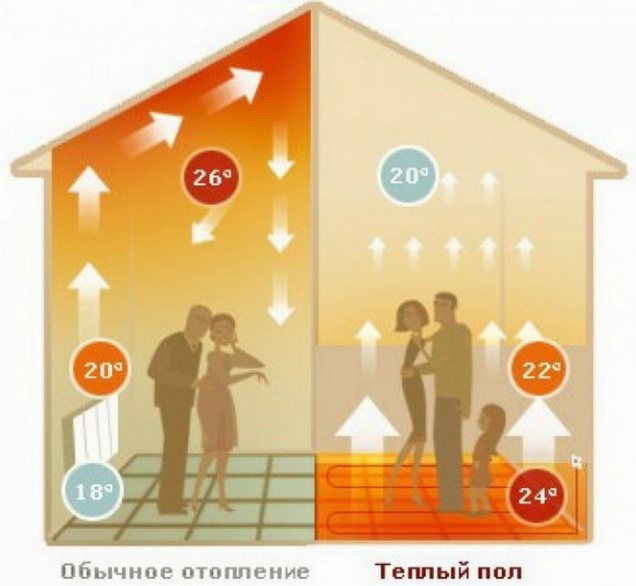

How the temperature is distributed
A floor covering heated to a low temperature heats the air, usually without the occurrence of circulating currents. At the same time, the air temperature at the bottom is the highest, and the lowest under the ceiling.
For example, it may be like this - at the floor - 24 degrees, at head level - 20 degrees, under the ceiling - 18 degrees. But the distribution will greatly depend on ventilation, air movements that are created in the room.
When heated by radiators, which are always hot, convection air movement occurs. At the same time, radiators have the highest air temperature, for example 40 degrees, it is also very hot under the ceiling above the radiator - 30 degrees, and in the rest of the room it is cooler, especially at the floor, 15-17 degrees, where a cold floor can be felt.
Floor surface temperature
The temperature of the heated floor should be comfortable for a person.
28 degrees C is the highest acceptable value for flooring with long-term presence of people. In rooms where people are occasionally (entrance hall and bathroom), the floor can (and comfortably) be heated to 30 - 32 degrees.
But most people choose the long-term comfortable temperature of warm floors much lower - 18 - 25 degrees, so that the warm floor does not distract, does not stand out, does not harm health.
Without batteries
Can underfloor heating be the only heating system without radiators? The answer is known - in our climate, even a well-insulated house cannot be heated in this way.
The only exception is the warmest subtropical regions. The main reason is the need to set a long-term comfortable low temperature on the floor covering. How the temperature in the underfloor heating system is regulated
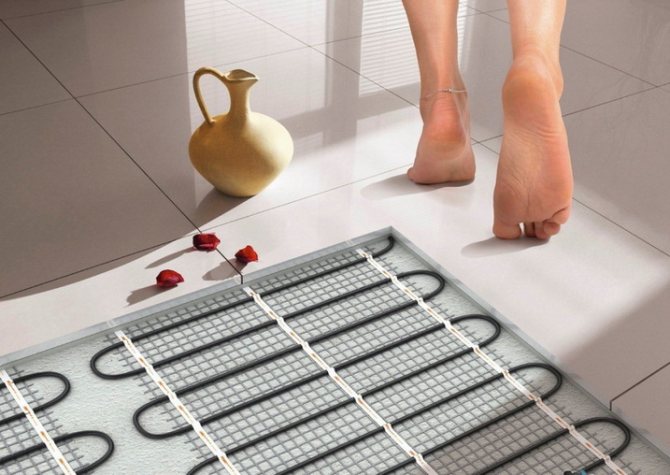

Dignity
Advantages (advantages) of a floor heating system.
- High comfort in the room, "feet do not freeze", you can lie on the floor, sit, play with children ... At the same time, the temperature distribution around the room does not feel uncomfortable, there are no cold zones in the corners, near the window ...
- Much less suspended dust in the air, no convection air currents raising dust.
- The total energy savings are usually 5 - 15%.It arises primarily due to the absence of a hot zone under the ceiling, and as a result of large heat losses through the ceiling due to a significant temperature difference.
Minuses
Disadvantages of the warmest floor and its creation.
- Constant presence in a room where the floor feels warm is discouraged by some medical professionals. The reason is that the development of diseases of the vascular system is possible, since the blood rushes to the heated parts of the body (legs). There are recommendations to reduce the temperature of warm floors, to bring them to a state of "natural naturalness" and not stay in rooms for a long time, in which the floors are felt as "warm".
- The absence of convection air flows reduces or negates air exchange between rooms. If there is no air flow through the cracks in the frames, then in a room with warm floors the air can generally stagnate, with the accumulation of harmful gases.
The role of ventilation is increasing
When creating warm floors in a room with sealed windows, it is necessary to equip ventilation, at least make supply valves with subsequent movement of air to the exhaust ventilation openings, which all rooms were previously equipped with.
How ventilation affects heat conservation
Concrete screed issue
A concrete screed weighs a lot - more than 2 tons per 10 square meters, creates a load on the floors. It is not always possible to create such a structure based on load conditions. The screed also reduces the height of the room.
In existing premises, the creation of such a screed is not always acceptable in terms of the height of doorways, the distance to the window sill and the height of the ceilings. The creation of a heavy screed can entail major repairs and alteration of the entire building.
It is possible to reduce the thickness of the screed by using metal heat dissipators - how to make heating with a dry prefabricated screed
Why does the temperature rise
When using a water-heated floor, the temperature often rises to 60-65 ° C, and the floor surface itself is only slightly warm. First of all, this is due to improper installation of the underfloor heating system. There are many probable reasons why the system is not working properly. Below are the most common ones.


Features of heat transfer in the room
- For thermal insulation when laying a warm floor, a very thin material was used or it is completely absent... Due to the lack of thermal insulation to warm up the room, it is necessary to overheat the system, since most of the generated heat evaporates.
- During installation, a large laying step was used, as a result of which the apartment cannot warm up to the optimum temperature.
- The heat loss of the house is too large and the system cannot compensate for them... Therefore, the warm floor does not cope with its main task.
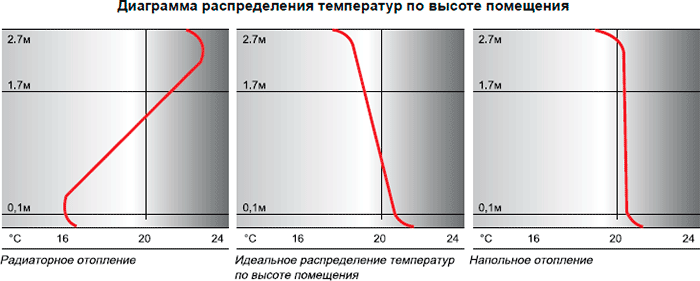

Room temperature distribution
When performing a thin screed, the floor surface warms up strongly, and after the temperature drops in the house it becomes cool. Such cases are quite rare, but in order to avoid problems with a warm floor, repair work should be entrusted only to experienced specialists. Of course, this can hit the pocket at the stage of repair, but it will save on electricity in the future.
Prices for warm floors "Teplolux"
Warm floors Teplolux
Teplosvetlo
The heating core of the heating cable can be heated up to 60-70 ° C. The temperature of the floor itself can reach 35-40 ° C. At the same time, it is usually not worthwhile to heat the floor to the highest possible temperature. This is due to the physiological characteristics of human tactile sensations. At surface temperatures above about 31 ° C, the warmth is no longer felt by the foot as comfortable.
According to SNiP 41-01-2003, p. 6.5.12 it is recommended that the average floor temperature does not exceed:
- 26 ° C for premises with constant presence of people,
- 31 ° C for rooms with temporary stay of people and bypass paths of swimming pools,
- the surface temperature of the floor along the axis of the heating element in childcare facilities, residential buildings and swimming pools must not exceed 35 ° C.
For children's institutions and premises with the constant stay of children, including preschool institutions, in accordance with the Sanitary Norms and Rules (VSN-49-86), the recommended floor heating temperature is no higher than 24 ° C. Similar rules apply abroad.
It is in order to avoid overheating of floors that most thermostats (thermostats) limit the upper temperature to 40 ° C. Note, by the way, that the temperature monitored by the thermal sensor corresponds to the temperature at the place of its installation. With a thick screed, it may differ from the temperature on the floor surface (the surface temperature is usually slightly lower). Therefore, by the way, it is recommended to install the sensor as close to the floor surface as possible. The use of cable heating systems without thermostats using, for example, simple switches, is generally prohibited. VTTKSO.
If you have any doubts that the floor temperature corresponds to the one you set on the thermostat, you can check it using, for example, an infrared thermometer. If the warm floor does not heat or does not heat well (it began to heat up much less than it was before), the floor temperature sensor may malfunction. The materials from the section will help you determine the cause yourself and eliminate it. underfloor heating repair... If you do not have sufficient skills, we recommend that you contact us for advice, see. underfloor heating repair: malfunctions and cost.
A separate issue is the temperature of the floor for coatings such as parquet and laminate. The use of a warm floor in this case requires more care and is not always advisable, because the same parquet floor feels much warmer than ceramic tiles. It should also be borne in mind that at a temperature of the order of 30 ° C in ordinary parquet, the destruction of the varnish coating and deformation can occur, which will never happen if you installed warm floor under the tiles... It is possible to lay warm floors under the laminate, this applies, first of all, to film floors, limiting their temperature to 27 - 29 ° C. At the same time, it is imperative to consult with the seller whether a particular laminate or parquet board is suitable for use with warm floors and to clarify the maximum temperature to be guided by when using a particular floor covering.
More on this topic: Tips for choosing a heating cable
Features of regulation
If we talk about the classification of automatic control systems for the operating mode of a warm floor according to the characteristics of work and the place of installation, then the following varieties are distinguished:
- zonal;
- are common;
- complex.
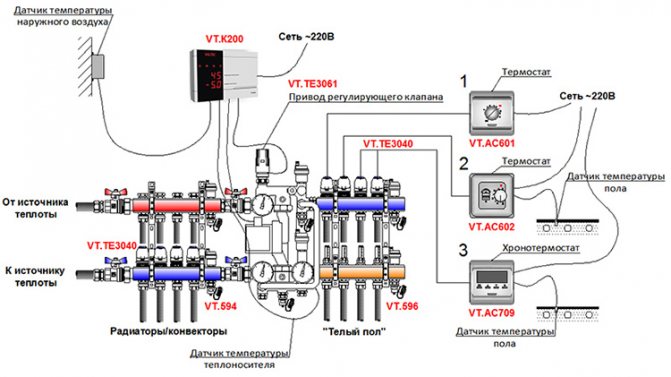

Underfloor heating temperature control
Under zone systems for regulating the temperature of the warm floor it is assumed that there is a separate control element for each room. Shared systems provide for the use of group system control in one apartment. The temperature is controlled as follows: the required temperature is set on a special device (thermostat), after which the signal is sent to the system control panel. With the receipt of the corresponding signal, the coolant moves from the system using valves with servo drives.
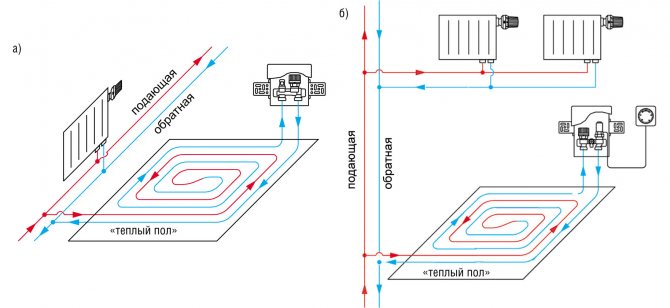

Image of water underfloor heating control
To increase the temperature, the coolant is started, and to decrease, on the contrary, it is removed from the floor heating system. Thanks to these actions, temperature control takes place. Depending on the type of thermostat and the characteristics of the system itself, the adjustment process may differ slightly.
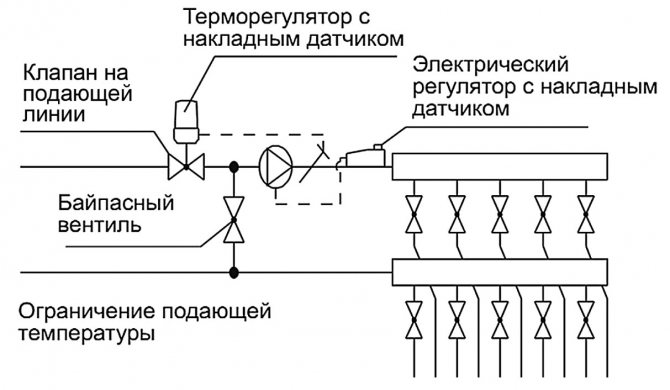

Underfloor heating scheme with injection
What temperature of the underfloor heating should be according to the standards?
For whom this may be a discovery, but the warm floor is practically not felt by the feet. In the literal sense of the word. You can walk barefoot on the floor, expecting that I am about to feel this warmth and learn all the charm of warm floors. But it was not there.
Adequate surface temperature of a water-heated floor does not exceed 28 degrees... That is why it is difficult to feel anything with your feet. The body temperature is simply higher. And all that you experience is comfort from the fact that your feet are not cold.
In this case, the temperature of the coolant on the boiler usually does not exceed 45 degrees.
Of course, the numbers are not absolute and there are adjustments up and down.
Temperature control
How to set the desired floor temperature and what methods of adjusting it exist? Below are the main temperature correction methods used in modern systems.
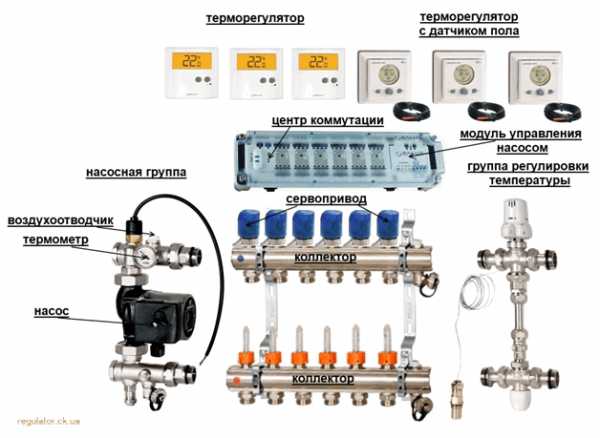

Manual adjustment of TP collectors
Table. Methods for adjusting the temperature of the warm floor.
| Method name, photo | Description |
| Group | A general method of temperature control, assuming the presence of a warm floor throughout the house or apartment. |
| Individual | Correction of the temperature mode of the underfloor heating in individual rooms, for example, in the bathroom or hallway. |
| Complex | Another way to adjust the temperature of the warm floor, combining all the above methods. |
Floor heating pipe contour length calculator
Go to calculations
The choice of the thermostat
I would also like to touch upon the thermostat itself, which plays a very important key role in this heating system. There are the following types of temperature controllers for underfloor heating:
Electronic and mechanical. The clarity of such an adjustment is approximate, so it is rather problematic to achieve a specific set temperature.
The main advantage of such a device is its low price.
Electronic. The setpoint is set using the touch buttons and has fairly clear settings and the ability to set the temperature limit up to one degree.
Programmable electronic. Due to the installation of such an element, it is possible not only to regulate the temperature regime in the room, but also to turn on the heating according to the schedule, or only if there is a person in the room.
By the way, some thermostats already have a built-in sensor, which makes it possible to control not only the floor temperature, but also the air in the room as a whole.
As a result, I would like to remind you of the rules for working with electrical equipment, all connection work is performed with the power off.


At the same time, it is necessary to ensure that no one, except the person performing this work, accidentally applied stress that is dangerous to human health and life. This is where our technology for installing a do-it-yourself floor temperature sensor ends. We hope the information provided was useful to you!
The most common way to implement underfloor heating systems is monolithic concrete floors, made with the so-called “wet” method. The floor structure is a "layer cake" of various materials
Using thermostats
To avoid overheating of the system, when installing a warm floor, a thermostat - a small device that regulates the temperature. There are three main types of thermostats: electronic, mechanical and programmable. All of them differ among themselves not only in name and price, but also in technical characteristics. Therefore, when choosing a product, it is imperative to consult with a specialist.


Types of thermostats for underfloor heating
After purchasing a thermostat, you need to install it correctly.Below is a step-by-step instruction for the installation of a regulator and a special temperature sensor, subject to which even a beginner can cope with this task. First, you need to make a small groove in the wall to lay the wire on the temperature sensor. Next, you need to follow the instructions.
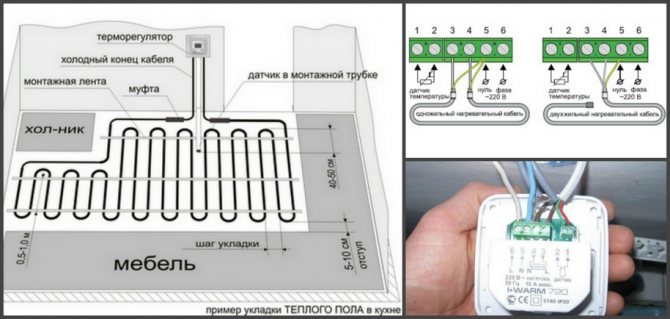

Connecting the underfloor heating controller
Step 1. Pass the wire with the temperature sensor through the corrugated tube (the diameter of the corrugation is selected in accordance with the dimensions of the wire).
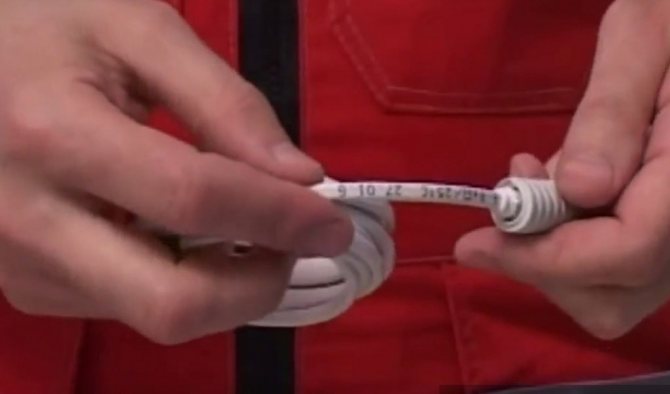

Thread the wire into the corrugated tube
Step 2. Carefully lead the sensor wire out from the other side of the corrugation.
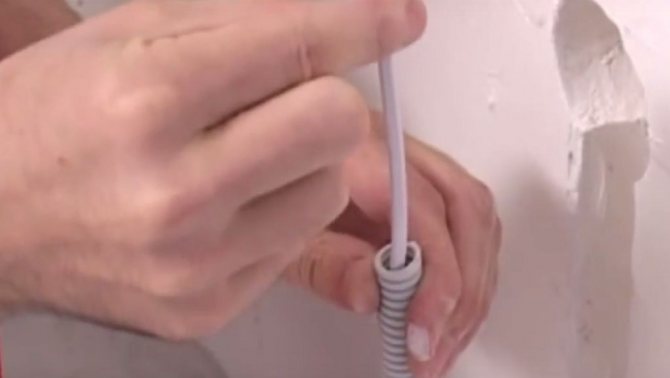

Lead the wire out from the other end
Step 3. Close the end of the tube from the side of the sensor using a special plastic plug. This is required to protect the tube from dust and mortar.


Install the plastic plug
Step 4. Fix the end of the corrugated pipe with the sensor between the heating circuits. For this purpose, it is advisable to use a special tape or strong clamps made of plastic.
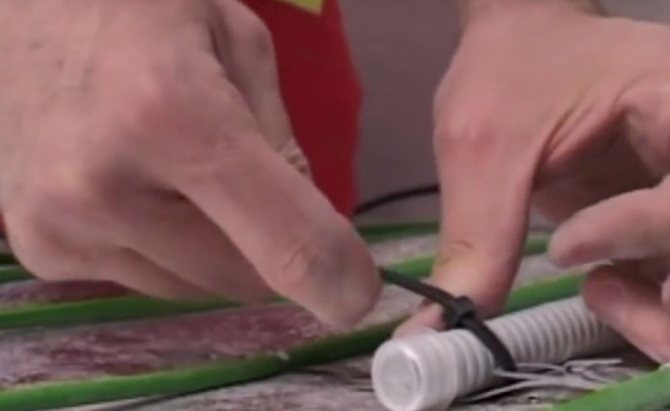

Secure the end of the tube
On a note! Do not install the temperature sensor very close to a stove, fireplace or electric heater. Due to the proximity, the readings of the temperature sensor may be unreliable.
Step 5. Lead the tube from the regulator to the floor, or rather, into the groove prepared in advance. Make sure that there are no strong bends in the tube.


Bring the tubes to the floor
Step 6... After installing the wiring and the special corrugated tube, seal the groove in the wall with cement mortar. The surface should then remain smooth and level.


Mask the groove with mortar
Step 7. Clean and tin the wires well. The functioning of the thermostat will depend on the quality of the work done.


Run the wires
Step 8. Connect the thermostat to the wires, and then install the device in its place. To do this, a hole must be made in the wall for the dimensions of the regulator.


Connect wires to thermostat
Step 9... Test all electrical connections for proper operation. After checking, turn on the underfloor heating system for a short time. This is necessary to check the health of the system.
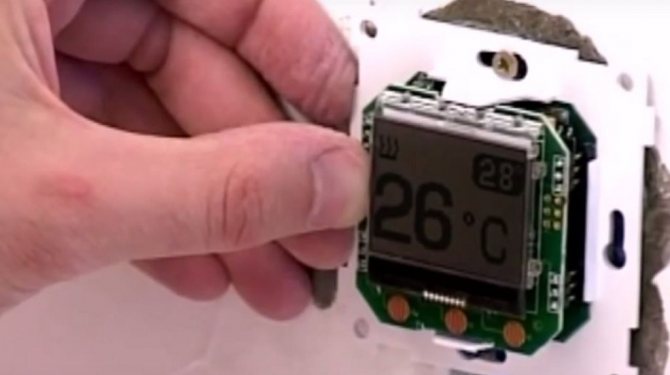

This is what the installed thermostat looks like
Step 10. If all is well and the floor heating system works, then a light on the thermostat, or rather, on its panel, will light up. The operability of the entire system will also be indicated by the heating of the floor surface. The diagram shows the installation location of the temperature sensor.
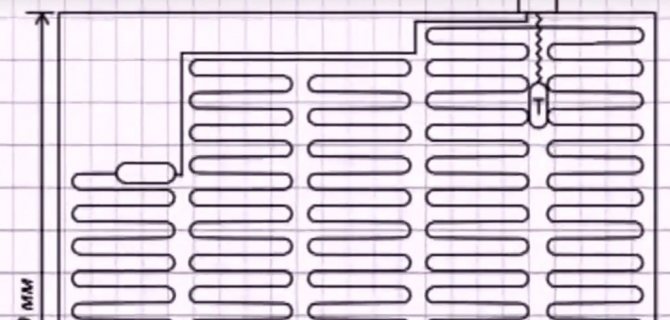

An example of a warm floor scheme
Additional recommendations
In order not to continue to face problems during the operation of a warm floor caused by an incorrect temperature regime, you need to follow a few simple rules:
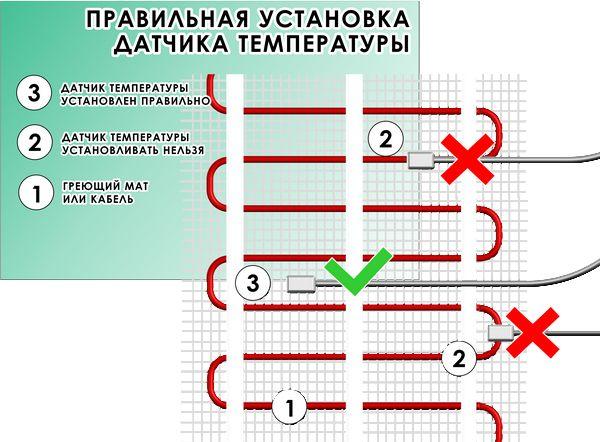

Correct installation of the temperature sensor
- thermal insulation during the installation of a warm floor must be of high quality. The best option is polystyrene foam. The thickness of the insulating layer is from 5 cm;
- the thickness of the screed must be sufficient, otherwise the floor will become very hot. Experts recommend pouring the screed about 3-5 cm above the pipe;
- there should be a step of 15 cm between the pipes, and if this is the edge zone of the room, then 10 cm;
- the system must be installed according to a previously prepared floor heating project in the house. This is the only way to avoid common mistakes during work.
Calculator for calculating the proportions of the manufacture of cement-sand mortar for floor screed
Go to calculations
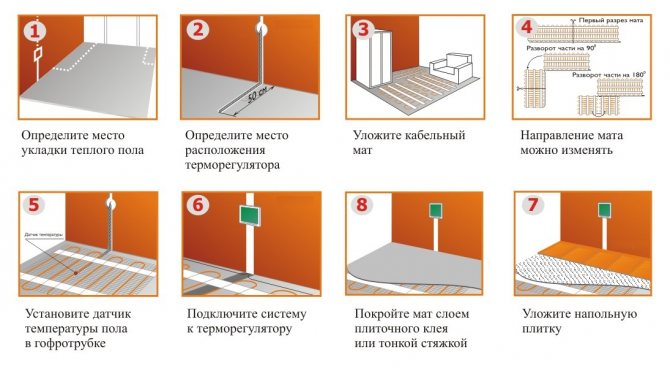

Sequence of work when connecting underfloor heating
The demand for underfloor heating is undeniable, since it is able to provide a given temperature in the room. Modern floor heating systems are a worthy addition to heating systems in the house.
Installation sequence
Let's proceed directly to the installation of a warm floor and a temperature sensor.
First you need to locate the thermostat, which will be located outside. It is located most often at a height of about 1 meter from the floor. Its fixing is similar to a regular socket.
Then you need to make grooves or grooves for laying two plastic pipes.
One for the power wire leading to the heating element, the other for the sensor wiring. The tube for the temperature sensor will be located on the floor. Such a gasket will make it possible, without removing the tile, to carry out repair work, at least to replace the control elements.
It will not be possible to completely replace the heating element if it is installed in the screed. It is important that when laying a pipe or corrugation for a cable, bends and turns are as few as possible. This will further simplify the replacement of a failed thermal sensor.


The next step is thermal insulation, it is performed individually for different types of heating elements, for example, for a heating cable, it is a damper tape or other insulation, the thickness of which is at least 1.5–2 cm. wires to the thermostat box.
Installation and connection of a floor heating temperature sensor has its own subtleties. In order to prevent the solution from entering the tube where the sensor is located, its end on the floor is securely sealed with electrical tape or tape.
It is not recommended to connect the entire system through an outlet; it is better to supply power from the circuit breaker and through the contactor (starter).
The temperature sensor should be installed at a distance of 0.5 to 1 meter from the wall on which the thermostat is installed, as well as exactly in the middle between two adjacent turns of the heating cable. After installation, it is recommended to fix the temperature sensor with mounting tape or foil tape.
Please note that thermal insulation must be laid under the temperature sensor, otherwise the heating system will not be effective.
Important point: The location of the temperature sensor should be chosen so that it is away from other heat sources. Otherwise, errors will occur and the warm floor will not work as it should.
Before making a screed, you need to check the performance of the warm floor and the temperature sensor itself. As a rule, the resistance of both elements is measured. The system is considered operational if the resistance differs by no more than 10% from the passport data.
In order for the assembled circuit to be as safe as possible, it is recommended to install residual current devices in rooms where electric floor heating is carried out, which, in the event of a breakdown, disconnect the circuit from voltage, thereby protecting a person from falling under an electric potential. This can be fatal in damp rooms.

